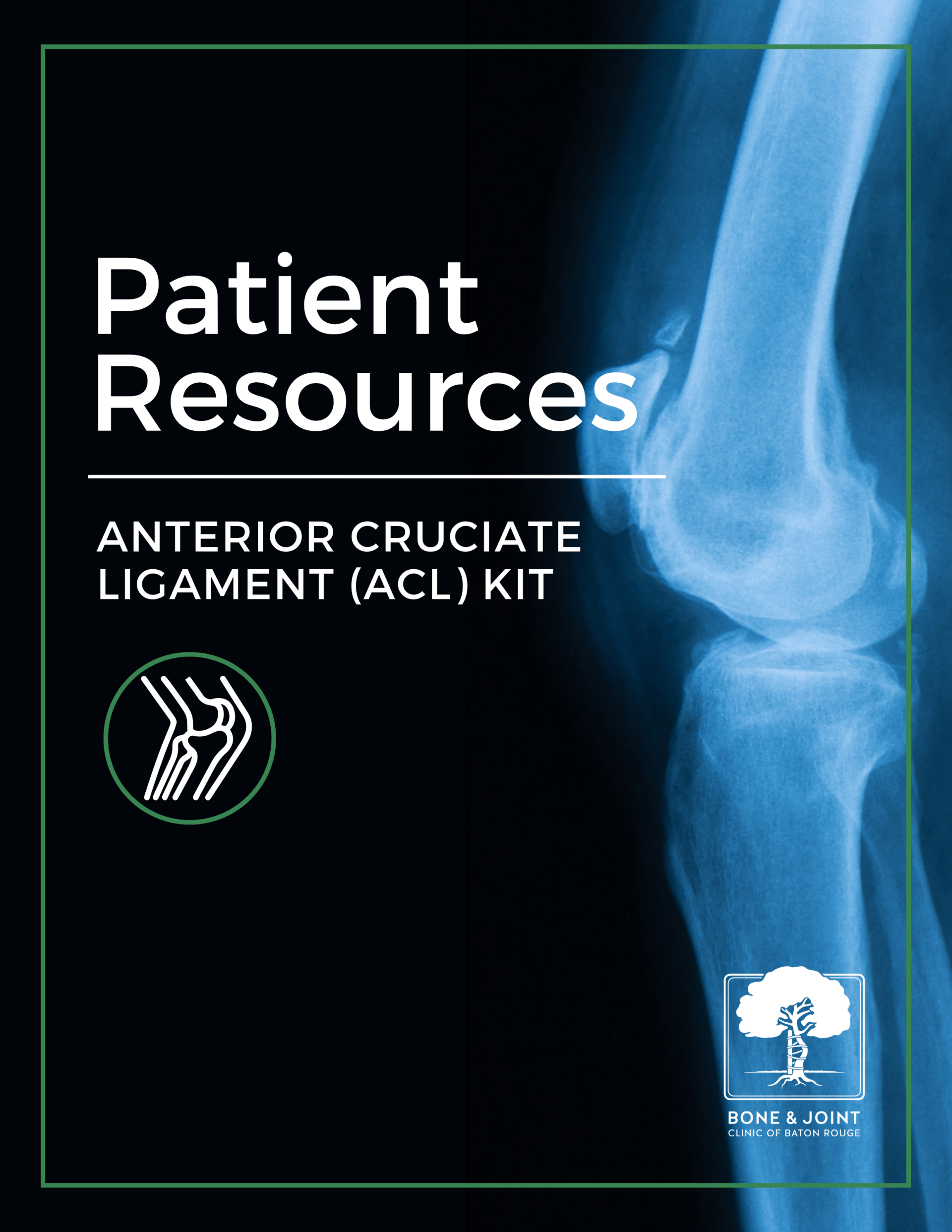Knee Injury Baton Rouge
RELATED PAGES
What Are The Most Common Types Of Knee Injuries?
Fractures, dislocations, sprains, strains, and tears are the most commonly reported knee injuries. The patella is the most likely knee structure to be broken or dislocated. Tears affect the ligaments that connect bones and muscles and cartilage that cushions joint bones.
When Is It Appropriate To Seek Medical Attention For Knee Pain?
When acute knee pain occurs, use RICE (rest, ice, compression, and elevation) to attempt to resolve the issue. Ibuprofen and other over-the-counter medications reduce inflammation and pain. If symptoms do not improve within 24 hours, schedule an appointment with an orthopedic physician. Redness, tenderness, and extreme warmth that does resolve with RICE are also valid reasons to visit a doctor.
Seek medical attention immediately if there is an extensive swelling, significant pain, or symptoms present with a fever. Injuries that cause an audible popping sound or make it impossible for the limb to bear weight merit a visit to emergency services.
What Should Patients Expect During A Physical Examination Of The Knee?
After gathering a thorough medical history, doctors discuss the symptoms patients are experiencing. Then, the doctor visually examines the affected joint. Gentle palpitations of the bones, muscles, and ligaments help medical professionals assess joint stability and pinpoint possible areas of damage. Range of motion exercises may also be used as an evaluation tool.
Imaging technology, like x-rays, CAT scans, and MRIs are essential tools that help physicians confirm a diagnosis or aid in developing a treatment plan. Blood tests maybe prescribed to uncover possible underlying conditions, such as gout or certain arthritic conditions.

What Are Some Common Causes Of Knee Pain?
Acute knee pain is most commonly caused by overuse and improper load-bearing technique. Impact injuries suffered during sports or accidents are other sources of sudden and intense pain around the knee.
A variety of musculoskeletal conditions can cause chronic knee pain. Arthritis, bursitis, poor posture while standing or walking and issues with the iliotibial (IT) band weaken muscles and cause misaligned bone structures. Malalignment causes friction and irritation which, over time, contributes to an increased inflammatory response and chronic pain.
How Is Knee Pain Treated?
Doctors use a variety of techniques to resolve knee pain. Prescription pain medications alleviate pain symptoms and allow the patient to rest comfortably while the body heals from injury. For chronic conditions, injections of cortisone, hyaluronic acid, or platelet-rich plasmas (PRP) may be prescribed for longer-term relief.
Physical therapy sessions strengthen the muscles that support the limb to increase physical ability and correct alignment issues. Assistive devices like arch supports, braces, walkers, and canes reduce joint pressure from everyday activities caused by arthritic conditions.
How Will I Know If I Need Knee Surgery?
In some cases, surgery is necessary to repair damaged joint structures. Torn cartilage, cysts, and fractures often need surgical intervention to facilitate healing. Doctors may suggest surgery when physical and prescription drug therapies fail to grant relief from chronic issues.

What Are The Different Types Of Knee Surgery?
Arthroscopic surgery allows physicians to enter the joint cavity through a small incision to remove loose bodies, remove damaged tissues, and reconstruct ligaments. Using a small camera and microscopic tools, doctors can navigate the joint without the need for a prolonged hospital stay. Meniscus repairs, transplants, ligament repair, and cartilage repair are common arthroscopic procedures.
Meniscus surgery is one of the most common orthopedic surgeries performed. Meniscus tears are very common, although not all meniscus tears need surgery. Some meniscus tears require removing the damaged tissue (meniscectomy), although new technology and surgical allow many meniscus tears being able to be surgically repaired. In some cases, a meniscal transplant can be performed to replace a meniscus that is damaged beyond repair.
ACL (anterior cruciate ligament) reconstruction is frequently need to fully restore function after an ACL tear. The ACL is crucial to maintain adequate knee stability. The ACL has very limited healing potential, and most ACL tears require “reconstruction,” using a new ligament or tendon to replace the injured ACL. In a small subset of patients, the patient’s own ACL can be repaired. Restoring knee stability with ACL surgery protects the knee from further cartilage and meniscus damage and allows patients to return to unrestricted activities.
What Is Knee Replacement Surgery?
Extensive damage may require a partial or total replacement of the knee joint called arthroplasty. The goal of knee replacement surgery is to remove damaged tissues and replace them with synthetic structures. Metal and plastic parts are used to cap boney joints and provide stability during motion. Partial replacements concentrate only on compromised tissues. In a full replacement, all parts of the knee joint are substituted for synthetic structures.
Who Needs Knee Replacement Surgery?
A partial or total knee replacement may be needed when less invasive therapy options are not effective. Severe loss of mobility, chronic and uncontrolled inflammation, and pain that interferes with sleeping and daily duties may indicate the need for surgical intervention. Consult an orthopedic surgeon for a personal assessment.
What Are The Alternatives To Knee Replacement?
The use of assistive devices like knee braces and walking canes mitigates knee pain and make it possible to perform many daily activities without the need for surgical intervention. A regular exercise routine increases blood flow to affected areas and encourages the body’s natural healing processes. Using a combination of physical therapy and pain medications or opting for less invasive arthroscopic procedures can delay the need for a knee replacement.
An alternative to knee replacement that is becoming more popular with patients is the cartilage regeneration procedure. This treatment for the knee utilizes your body’s stem cells to regrow lost cartilage by combining a surgical approach with in-office injections.

Download the ACL Patient Kit today
All about ACL injuries in one place.
Learn more about injuries of the Anterior Cruciate Ligament (ACL)
Injuries of the anterior cruciate ligament (ACL) in the knee are common, particularly among athletes. Learn more about the ACL, the type of injuries it may sustain, who is most at risk, and more in this comprehensive patient kit.
Knee Surgeons in Baton Rouge
Knee pain is no fun which is why we want to get you back to moving more and hurting less. As leaders in assessing, diagnosing and treating knee injuries, our team of knee experts will provide a treatment plan centered around you. Take the first step towards living without knee pain by scheduling an appointment today.
-
JOSEPH E. BROYLES, M.D.
Joint Replacement Surgery
Hip and Knee Arthroscopy
Cartilage Regeneration
VIEW BIO
-
ARTHUR E. HESS, M.D.
Pediatric & Adult Orthopedic Trauma
Hip, Knee & Shoulder Reconstruction
Hip Preservation
Total Joint Replacement Surgery
Robot-assisted total knee arthroplasty
General Orthopedics
VIEW BIO
-
MATHEW J. MAZOCH, M.D.
General Orthopedics
Sports Medicine
Shoulder Surgery
VIEW BIO
-
GERARD L. MURTAGH, M.D.
Shoulder Arthroscopy
Computer-Assisted Joint Replacement
Sports Medicine
VIEW BIO
-
JULIE NEUMANN, M.D.
Shoulder Arthroscopy
Knee Arthroscopy
Sports Medicine
Foot & Ankle Specialist
Orthopedic Conditions & Injuries
VIEW BIO
-
DAVID M. POPE, M.D.
Sports Medicine
Computer-Assisted Joint Replacement
General Orthopedics
VIEW BIO
-
ALAN C. SCHROEDER, M.D.
Shoulder Arthroscopy
General Orthopedics
Orthopedic Sports Medicine
VIEW BIO
RELATED READING
Advancements in Knee Treatment in Baton Rouge
Stay updated on the latest advancements in diagnosing and treating the knee with the Bone and Joint Clinic of Baton Rouge.
MOVE MORE, HURT LESS.
QUICK LINKS
SIGN UP FOR OUR NEWSLETTER:
7301 Hennessy Blvd.
Suite 200
Baton Rouge, LA 70808
tel: (225) 766-0050
fax: (225) 766-1499
4463 LA 1 South
Suite A
Brusly, LA 70719
tel: (225) 766-0050
fax:
(225) 766-1499
19065 Dr. John Lambert Dr.
Suite 2100
Hammond, LA 70403
tel: (225) 766-0050
fax: (225) 766-1499
16158 Airline Hwy.
Prairieville, LA 70769
tel: (225) 766-0050
fax: (225) 766-1499
5000 O'Donovan Blvd.
Suite 306
Walker, LA 70785
tel: (225) 766-0050
fax: (225) 766-1499
Bone & Joint Clinic of Baton Rouge, Inc. complies with applicable Federal civil rights laws and does not discriminate on the basis of race, color, national origin, age, disability or sex.
Click to view our notice.
Bone & Joint Clinic of Baton Rouge | All Rights Reserved.









